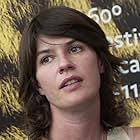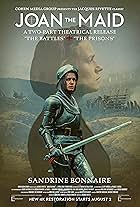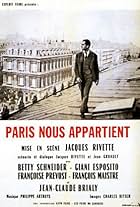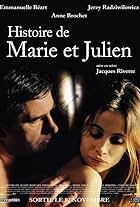VALUTAZIONE IMDb
6,8/10
1201
LA TUA VALUTAZIONE
Aggiungi una trama nella tua linguaA drama following 4 women at stage school. Considered by some to be the summation of director Jacques Rivette's work as a whole.A drama following 4 women at stage school. Considered by some to be the summation of director Jacques Rivette's work as a whole.A drama following 4 women at stage school. Considered by some to be the summation of director Jacques Rivette's work as a whole.
- Premi
- 3 vittorie e 2 candidature
Inês de Medeiros
- Lucia
- (as Ines d'Almeida)
Trama
Lo sapevi?
- QuizLucia talks to the ghosts and recites some kind of spell in her native Portuguese language. It is inferred that she is a witch. This may be an implicit reference to Julio Cortazar's Rayuela, whose main character, La Maga (real name, Lucia), is also a witch, of Uruguayan descent. The image of both heroines is very similar, in addition to the name. And Rayuela is also set in Paris.
- ConnessioniFeatures Un jeu brutal (1983)
- Colonne sonoreHor ch'el ciel e la terra
Music by Claudio Monteverdi
Solistes, choeur et orchestre de la Societa cameristica di Lugano
Conducted by Edwin Loehrer
Recensione in evidenza
"Gang of Four" is hard to find words for. However I think it does address, in a detached and engaging manner, the themes of coming-of-age and community in the lives of several young women at an elite prestigious acting school?
And gender seems to be the most specific definer of these themes. The teacher, Constance, at some point in her professional career, made the decision to exclude male students from her school. This in turn informs the lives of her young actors, who are each expected to play male role and female roles. Claude seems especially affected by this form of teaching and experiences much confusion in discerning men and in her own gender identity.
Lucia, another of the four, has disgraced her family over her refusal to marry a pre-selected husband. Anna, whose actual name is Laura, takes this name to hold the memory of her missing sister close to her thoughts and actions. Cecile is not one of the gang of four (she left this residence house earlier) but she is having much of her identity shaped by a relationship to Antoine, who seems to be involved in some kind of dubious radical or criminal activities (this was never clear to me).
And then there's Thomas who seems to be the cross between a mole and a eunuch, who slithers into the the female household, in his ostensible pursuit of the elusive Antoine. However, his unstated purpose seems to be to disrupt and control the individual lives and growing commonality of the four women. He manipulates one woman against another by seduction, lies, and feigned heroism. And with an unrelenting mocking presence for which he has no compunction he puts the full disruptive burden of his presence onto them If it's Constance's resolve to exerts a kind of pressure on her charge's youthful insecurity and dependency and steer them clear of false emotions, Thomas' resolve is to break their solidarity, not test it.
Despite the drama on and off the stage, and all the motion, energy, body language, gestures, declamations, and tantrums, the general effect is both low key and even. No one stands out except perhaps Laurence Cote and Bulle Ogier as Claude and Constance. In the end, all the closures and variables in the lives depicted seem begin to co-exist. The young women come to inhabit their own scripts, and this in a world without and sometimes in spite of men.
And gender seems to be the most specific definer of these themes. The teacher, Constance, at some point in her professional career, made the decision to exclude male students from her school. This in turn informs the lives of her young actors, who are each expected to play male role and female roles. Claude seems especially affected by this form of teaching and experiences much confusion in discerning men and in her own gender identity.
Lucia, another of the four, has disgraced her family over her refusal to marry a pre-selected husband. Anna, whose actual name is Laura, takes this name to hold the memory of her missing sister close to her thoughts and actions. Cecile is not one of the gang of four (she left this residence house earlier) but she is having much of her identity shaped by a relationship to Antoine, who seems to be involved in some kind of dubious radical or criminal activities (this was never clear to me).
And then there's Thomas who seems to be the cross between a mole and a eunuch, who slithers into the the female household, in his ostensible pursuit of the elusive Antoine. However, his unstated purpose seems to be to disrupt and control the individual lives and growing commonality of the four women. He manipulates one woman against another by seduction, lies, and feigned heroism. And with an unrelenting mocking presence for which he has no compunction he puts the full disruptive burden of his presence onto them If it's Constance's resolve to exerts a kind of pressure on her charge's youthful insecurity and dependency and steer them clear of false emotions, Thomas' resolve is to break their solidarity, not test it.
Despite the drama on and off the stage, and all the motion, energy, body language, gestures, declamations, and tantrums, the general effect is both low key and even. No one stands out except perhaps Laurence Cote and Bulle Ogier as Claude and Constance. In the end, all the closures and variables in the lives depicted seem begin to co-exist. The young women come to inhabit their own scripts, and this in a world without and sometimes in spite of men.
I più visti
Accedi per valutare e creare un elenco di titoli salvati per ottenere consigli personalizzati
- How long is The Gang of Four?Powered by Alexa
Dettagli
Contribuisci a questa pagina
Suggerisci una modifica o aggiungi i contenuti mancanti

Divario superiore
By what name was Una recita a quattro (1989) officially released in India in English?
Rispondi





















